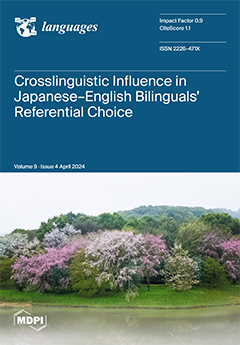This study aimed to identify the impact of English language proficiency on Bangladeshi graduates in terms of its influence on local languages and cultural integration. The study was conducted using a quantitative approach, and the random sampling technique was employed to select 370
[...] Read more.
This study aimed to identify the impact of English language proficiency on Bangladeshi graduates in terms of its influence on local languages and cultural integration. The study was conducted using a quantitative approach, and the random sampling technique was employed to select 370 respondents from English and Bengali medium-instructed Bangladeshi graduates. Data were analysed using SPSS version 27.0. The Pearson correlation, ANOVA, and multiple regression analyses were used in line with the research objectives. The Pearson correlation shows a significant correlation among the studied variables, such as cultural erosion
(R2 = 047,
p < 0.001), threat to local language (
R2 = 048,
p < 0.001), and polluting local language (
R2 = 047,
p < 0.001). The ANOVA test was performed to find the mean difference in cultural erosion (CE), threat to local language (TLL), and polluting local language (PLL) with respect to respondents’ qualifications (bachelor’s, master’s, or Ph.D. degree). The ANOVA result revealed no statistically significant difference in CE and TLL in terms of graduates’ qualifications, while PLL differs significantly based on their qualifications (bachelor’s, master’s, or Ph.D. degree.). Similarly, significant differences in CE, TLL, and PLL were found among the income groups and living places of graduates. Multiple regression analysis explained 13.6% variances in the social class context with ELP-linked challenges (
R2 = 0.136,
p = 0.001), while the lower class was found to have positive non-significant relationships with ELP-linked challenges (
B = 0. 159,
p = 0.382). This was almost double that of the result for the rich class (
B = 0.085,
p = 0.721). However, ELP-linked challenges contain a mixture of languages and cultural blending in society, as the rich class faces fewer challenges than the lower and middle classes. The study is influential in creating an awareness of language use whenever necessary.
Full article





